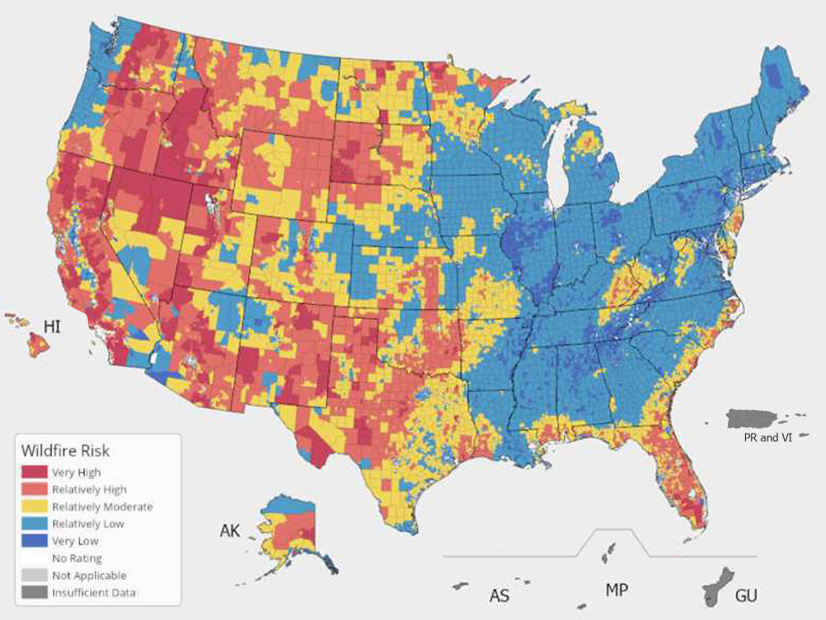
Arizona Public Service is prepared to implement public safety power shutoffs for the first time this year, and another utility in the state is laying the groundwork to use the wildfire prevention technique.
“It is a tool that we expect to use very, very seldomly, but one that we are prepared to use if conditions warrant,” said Scott Bordenkircher, APS forestry and fire mitigation director.
Bordenkircher’s comments came during an Arizona Corporation Commission workshop April 23 on electric utilities’ summer preparedness.
Salt River Project is also evaluating the possibility of a public safety power shutoff (PSPS) program.
“We are in the development stages and looking at what that could look like for SRP,” Jace Kerby, director of transmission line design, construction and maintenance at SRP, said during the workshop.
The utility has brought in a vendor to help model wildfire threat in SRP’s service territory — information that would be key in designing a PSPS program, Kerby said.
Utilities in other Western states have used PSPS as a wildfire prevention technique. In California, there have been 72 preemptive shutoffs since 2018, according to a California Public Utilities Commission dashboard.
Oregon’s first PSPS event was in 2020. (See High Fire Danger Prompts First Oregon PSPS Event.)
Xcel Energy implemented the first PSPS in Colorado in April in response to a severe windstorm forecast. The shutoff affected an estimated 55,000 customers April 6-7.
After the event, Gov. Jared Polis (D) criticized the utility for failing to minimize outages and effectively communicate with customers. The Colorado PUC has opened an investigation into Xcel’s use of PSPS and will explore potential regulation of prescribed outages.
As the risk of wildfire increases nationwide, some predict that more states will be facing public safety power shutoffs.
“Ultimately, it’s a national push. This will happen very likely with all utilities in the nation very soon,” Commissioner Nick Myers of the Arizona Corporation Commission said during a wildfire mitigation town hall meeting April 4.
PSPS Design
Bordenkircher at APS said the utility has targeted 13 circuits in high fire-risk areas in Yavapai, Coconino and Gila counties for potential power shutoffs.
He said shutoffs would occur during “really bad fire weather,” when high temperatures, low humidity and strong winds elevate the risk of wildfires igniting and spreading quickly. He estimated that a shutoff would last about 20 hours, from when winds pick up in the afternoon and evening until crews could get out the next morning to inspect power lines for damage. Customers would be alerted four days in advance of a potential shutoff.
Kerby said SRP is exploring circuit segmentation to reduce the number of customers affected by an outage if the utility proceeds with PSPS.
Utilities are taking other steps to reduce wildfire risk, with two goals: to prevent utility equipment from starting wildfires and to protect utility infrastructure from wildfires of any origin.
Kerby at SRP said vegetation management “has got to be the biggest key component to helping drive down the risk when it comes to wildfire mitigation.” Utilities are clearing vegetation from rights-of-way, removing trees at risk of toppling onto lines and clearing space around power poles.
Another strategy at SRP is replacement of wooden poles with steel in its transmission and distribution systems. Tucson Electric Power (TEP) also has a pole-replacement program.
High-tech Approaches
Other wildfire mitigation efforts are more high-tech.
SRP has installed 12 artificial intelligence smoke-detection cameras on its transmission system as part of a research project. The cameras learn the topography in a 10-mile radius and send an alert if smoke is spotted. A limitation is that transmitting the data requires cellular service, Kerby said.
TEP is also testing a fire detection system in the Gila National Forest and in grassland areas around Fort Huachuca.
APS is adding weather stations and cameras to its circuits to better monitor conditions.
The utility is using covered conductors in high fire-risk locations and undergrounding lines “where it makes sense,” APS’ Bordenkircher said, noting the difficulty of digging through granite prevalent in parts of the state.
Another upgrade in fire-prone areas is expulsion-limiting fuses, which contain sparks rather than letting them fall to the ground. APS is using the fuses, as is TEP.
Kerby said SRP partners with APS on a “no reclosing program” for circuits in high fire-risk areas. If a fault occurs on one of those circuits during periods of high fire danger, it will remain out of service until it’s been inspected and found to be in good condition, he said.
Ultimately, Kerby said, “It should be every utility’s end goal to not need a PSPS,” and measures including equipment replacement, system hardening and vegetation management will help make that possible.
“[So] that ultimately our system is in a good enough shape and the environment around the system is in a good enough shape that it can withstand the environmental conditions that could come its way,” he said.
